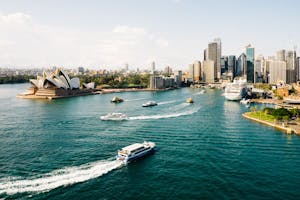- 5 minute read
- Email Marketing
3 Simple Methods To Make Customers Open (And Read!) Your Emails
Beginner,
Intermediate
Join hundreds of other operators and REGISTER NOW for Spark 2024 New Orleans October 13-15th!

Preparing for the busy season is crucial for tour and activity operators to maximize revenue and provide exceptional customer experiences.
Each region and activity type presents its own unique challenges and opportunities, but no matter where your business is located, considerations like seasonal variations, marketing strategies, and localized content are essential for making the most of your busy season.
In this article, we cover some of the ways tour operators in Australia and New Zealand can prepare for an influx of customers, and highlight some travel trends unique to this region that have the power to shape the experiences you offer.
The lead up to your busy season can be, well, busy. Handle these items ahead of time for a smooth season.
 FareHarbor Dashboard
FareHarbor DashboardFirst things first, all of us at FareHarbor want you to feel confident that your Dashboard is set up for success. This pre-busy season Dashboard checklist will get you up to speed. It covers items like adding staff members to the Dashboard, updating last season’s item descriptions, and more.
 Marketing & SEO
Marketing & SEOAs you prepare for your peak season, strive to successfully market your tours and activities to attract an influx of bookings. There are several ways to make sure your marketing and SEO strategy is up to snuff, like placing your best-selling items prominently on your website, reviewing your target keywords, and more. See the full list here.
 Hiring & Staff Training
Hiring & Staff TrainingWhile your online presence works to drive customers to your business, your staff are responsible for giving them an amazing experience on-site. Whether you have all returning staff or are hiring some new team members, explore everything you need to know about seasonal staff training before things really start getting busy.
Another peak season means returning and new customers. So who are these visitors to your business?
Utilizing tools like Google Analytics, FareHarbor reporting, and social media analytics will help you fill in the blanks. Demographic details like age, location, and interests can tell you a lot about your audience (and how to market your activities to them).
It’s also a good idea to stay abreast of trends and developments in the tourism industry as well as your local area.
For example, did you know that Australia’s biggest percentage of inbound travelers comes from the United Kingdom and the United States (Think with Google)? If many of your customers are from these countries, think about how to best cater your activities to them.
New Zealand is a popular destination worldwide, but the country that sends the most international tourists to New Zealand is Australia (Dream Big Travel Far).
You should research these areas and markets to get an understanding of what kind of tourists come from there and what they expect during their travels.
Don’t forget to analyze how customers discover your business, as this helps you tailor your marketing strategies. For instance, 48% of Australian survey respondents said social media influences where they travel next (Skyscanner AU) and 61% of Kiwis have wanted to book a trip to a destination after seeing it featured in a movie or show (Expedia).
There are several ways to explore how customers learn about your business:
Understanding the prevailing interests, trends, and travel preferences of people in your region (including international visitors) is key for adapting your marketing strategies and even your offerings if you’re up to the challenge.
Knowing how far in advance customers typically book can have a big impact on how you do business. It can tell you when is the best time to update your website ahead of your busy season, how soon to build out next year’s booking calendar, and when your online booking cutoff should occur.
When you know your customers’ booking patterns, you have a leg up on planning initiatives like promotions and marketing (such as driving early season bookings, for example). For a business that attracts primarily last-minute or same-day bookings, your marketing strategy would differ compared to a business whose customers book well in advance.
In order to determine exactly when your customers book, these three FareHarbor reports are a great place to start. They will tell you:

While the above reports use your unique data, it’s also interesting to note that some Australian travelers tend to book well in advance. According to News Corp, 32% of respondents said they booked more than seven months in advance, compared to 20% in the previous year, 2022.
If this trend matches what you’re seeing at your specific business, make sure you are prepared to receive bookings in advance. Having your booking calendar built out ahead of time ensures customers have plenty of options to meet their needs.
Good news for tour and activity operators: 60% of surveyed Australians are willing to spend more on experiences while on holiday (Travel Weekly)!
What does that mean for you? More opportunities to generate revenue from things like upsells, add-ons, and upscale experiences.
Consider pricing strategies like seasonal and peak pricing, time of day pricing, and packages. It’s also helpful to analyze your fixed and variable costs when determining whether you want to raise your prices.
Add-ons and upsells like transportation, meals, alcohol, and souvenirs can result in more money in your pocket, especially while Aussie travelers are willing to splurge on holiday.
You could benefit from increased demand in specific activities if you are willing to adapt your existing offerings or expand into a new niche. In 2023, the most popular tourism trends for ANZ travelers are food tourism, wellness tourism, and sustainable travel (Travel Weekly).

In New Zealand, food and accommodation are up 10.3% on pre-pandemic levels (Statistics NZ).
Can any of your activities be adapted to meet this demand? For instance, can you partner with a restaurant, add food to your experiences, or offer some wellness activities like yoga and spa treatments? Consider exploring these ideas, as well as luxury tourism and private or custom tours.
As you gear up for your busy season, understanding customer habits and travel trends will give you a leg up on your competition. As always, your Dashboard, staff, and website must be fully optimized before your bookings really start coming in. Explore the related guides below for a successful busy season.